Supported operating systems and installation
Supported operating systems: Microsoft Windows 11, 10, 8.x, 7, Vista SP2, Server 2012, Server 2008. Embedded versions of Windows are not supported. To install 232key, simply download the installer, run it and follow the instructions on your screen.
Basic setup and use of 232key
Before starting 232key, please make sure that your serial device is switched on and connected to your PC!
Choose COM port, device, interface parameters and terminator
COM port
Go to the input tab and choose the serial port (COM port) your device is connected to:
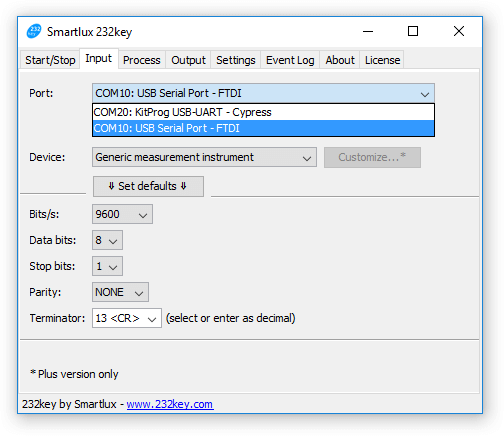
You can also try to let 232key detect the port automatically by switching off all other serial devices and pressing the auto button (only works with devices which support hardware handshaking):

Device
232key supports two basic types of devices. It is important that you choose the right type:
- Numeric devices: Measuring instruments and other devices sending a number: Select this type if your goal is to capture a measurement value from your device (e.g. the weight from a scale). Almost all devices in the list belong to this type.
- Text devices: Select this type if you want to capture a text string in its entirety (e.g. a barcode). Text devices appear in italics in the device list. Currently, the name of all devices of this type starts with " Barcode".
If your device is present in the drop-down list, select it and press ⇓ set defaults ⇓ to set the default interface parameters and terminator. If it is not present, select "Generic measuring instrument" to capture numbers or one of the "Barcode" devices to capture text, then proceed to the next step.
Currently, default settings for the following serial devices are predefined in 232key:
- A&D scales and balances ( advanced support)*
- A&D EM ("emerging markets") scales ("auto-print" mode only)
- Acculab AL series
- Adam AZextra price computing scales (weight in kg only, best label format is "LAbEL 3"). Note: 232key is not certified for use in direct sales to the public ***
- Adam CBK/GBK/GFK scales (set to "C8 LAb oFF", for older scales without this setting please use "Adam label format")
- Adam CPWplus scales (mode "trn 3")
- Adam GBC/GFC scales (either weight or pcs) ***
- Adam Highland (HCB) balances (RS-232 and USB), output format 2 only ("FOr 2")
- Adam label format (for Adam Equipment scales and balances using a format designed for serial printers) ***
- Dini Argeo (profile should work with most of their weighing instruments)
- Dini Argeo DFW/DFWL
- Denver Instrument
- Kern 440 balances
- Kern 572 precision balances **
- Kern ABP, ABT, ACJ, ACS, PBJ, PBS balances (same as Shimadzu)
- Kern DE scales/indicators
- Kern DS platform scales
- Kern FKB bench scales **
- Kern KB-N precision balances **
- Kern KCP (Kern Communication Protocol, supported by more and more Kern scales and balances)
- Kern KFB indicators (IFB scales) *
- Kern MPS/MPT/MXS/MWS/MTS/MCB medical scales ***
- Kern RPB price computing scale (weight in kg only, set F8 to "print" to enable RS-232, price must be entered before pressing print key on scale, weight must be equal or larger than Min). Note: 232key is not certified for use in direct sales to the public ***
- Keyence IL Series Laser Sensor (one sensor with DL-RS1A RS-232C Communication Unit and external input to DRQ terminal) ***
- Mars Scale
- Mettler-Toledo MT-SICS protocol (for modern Mettler Toledo scales and balances) **
- Mettler-Toledo Dialog **
- Mettler -Toledo Print (for older MT scales) **
- Mitutotyo 264-007 ***
- Mitutoyo LSM-6200 ***
- MyWeigh HD scales (older models with RS-232 port) *
- MyWeigh Ultraship-U2 (only models with virtual COM port, VCP driver installation may be required)
- Ohaus scales and balances (please set laboratory balances to "numeric value only")
- Ohaus legacy Scout Pro, Traveller and Navigator scales (for recent Navigator scales, use "Ohaus" profile instead)
- Precisa scales and balances
- Radwag scales and balances
- Rice Lake 1280 weight indicator (using the default data format)
- Sartorius scales and balances **
-
- Scale Manufacturers Association Standard Scale Serial Communication Protocol (supported by several manufacturers) *
- Schlage HandPunch (employee ID only) ***
- Shimadzu
- Tanita TL-280/TL-290 scales ***
* supports automatic port detection.
** untested.
*** requires a Plus license.
Known incompatible devices:
- Jadever SNUG II-150 precision balance (can only send data continuously).
Interface parameters and terminator
If your device is not included in the device list or if you're not using its default settings, you have to manually set the interface parameters (bits/s, data bits, stop bits, parity) and the terminator character which marks the end of each line of data.
Please consult the instruction manual of your serial device to find the appropriate settings. If the number of stop bits is not specified, select "1".
The terminator is the very last character in each line of data sent by your device. You can select one of the pre-defined values or enter any ASCII code as a decimal value.
Terminator example from a user manual
![]()
The very last character is "line feed" (ASCII code 10), therefore choose "<10> LF" as the terminator in 232key.
If you have trouble finding the terminator, we recommend
using a terminal program like HTterm
to analyze the data sent from you device. In the example below,
you can see that the very last character is again "line feed"
(decimal ASCII code 10):

We'd appreciate if you could post the name of your device and your settings in our support forum so that we can add a new device profile to 232key. Thank you!
Specify output format
Switch to the output tab. Please select the keyboard type you're using (this is particularly
important if you want to transmit alphanumeric characters or If
you're using a French AZERTY keyboard):
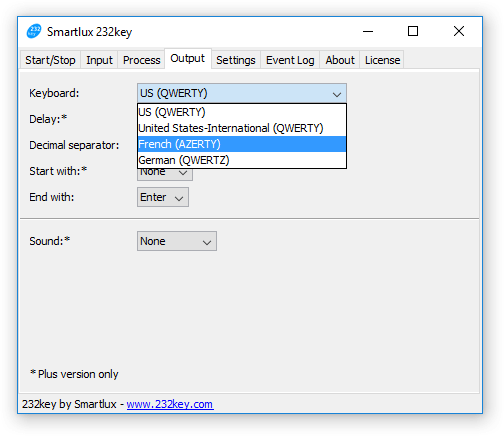
If your keyboard layout is not listed, you can choose the "All (compatibility mode)" setting (available since version 2017.1.2.0). 232key will then use the Alt numpad input method:
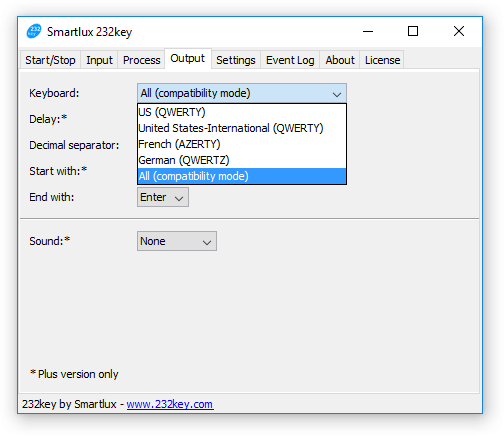
Next, select the decimal separator you want 232key
to use when
typing decimal numbers: "dot" (e.g. 10.00) or "comma" (e.g. 10,00):
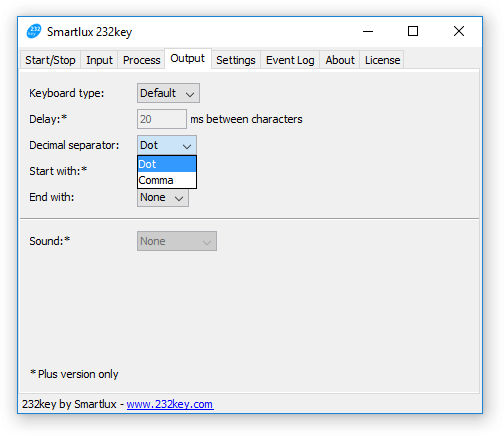
- This only concerns 232key's simulated keystrokes. The decimal separator of the numbers sent from your device is automatically recognized.
- This setting is only available for "number" devices (and disabled for " text" devices).
Under end with, you can instruct 232key to send an additional keystroke
after each value (e.g. the "Enter" key to jump to the next row in a
spreadsheet):
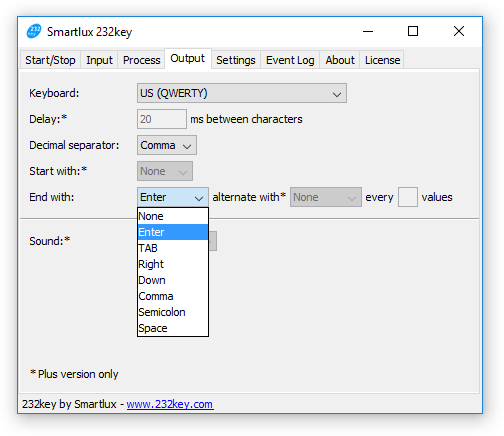
Allows you to specify a key to be pressed ahead of the data. As of version 2020.1, you can select one of the following keys:
- Enter
- TAB
- * (Numpad)
- Comma
- Delete
- Down arrow
- Esc
- F1-F12 function keys
- Right arrow
- Semicolon
- Space
As you can see from the disabled settings in the screenshots, many additional features are available in the Plus version of 232key.
Start 232key and transmit data
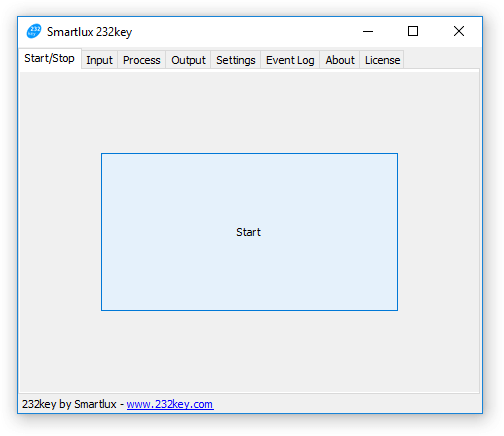
Press the start button and switch to the target program (e.g. a spreadsheet software). Place the cursor where you want the data to be typed. Press the data transmission button on your device (often labeled "data" or "print") and watch as the value is typed into the target program.
Advanced 232key Plus functionality
Custom Regular Expressions
Added in version 2016.2
Generally, 232key will capture the first number it encounters (or the first alphanumeric sequence of characters if you've selected a "barcode" device). This works for many devices, but not always: Some devices might send another number ahead of the measurement value, e.g. a model number. Until the release of version 2016.2, the only thing you could do in this situation was to contact us and ask us to add a new custom device profile to 232key. Now, you can simply click on Customize and edit the regular expression used to match and capture the data yourself:
Example: Selecting "Barcode alphanumeric" and
clicking on Customize lets you edit the regular
expression used to capture and match alphanumeric data:
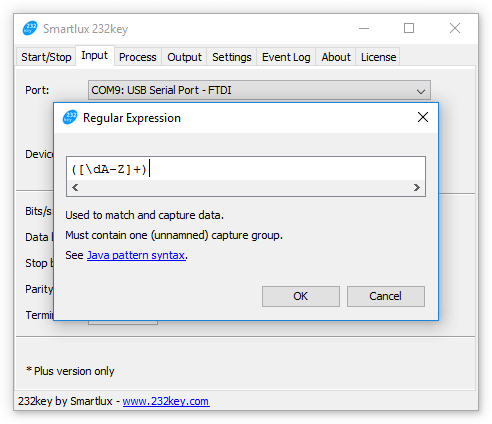
- You must include an unnamed capture group in your expression (in parentheses). 232key will try to match the entire expression, but will only capture the data within the first capture group.
- Please select an appropriate device as your starting point: Most devices are meant to work with numerical values! Only the " Barcode alphanumeric" and "Barcode alphanumeric extended" devices can actually type a limited set of non-numerical characters.
- 232key uses the Java pattern syntax.
Remove or keep first/last X characters (edit)
Added in version 1.60
If the data captured from your device contains a fixed number of unwanted characters at the beginning or end, you can remove them by using the edit function. You can either specify the number of characters you want to remove or the number of characters you want to keep. If no value is entered, the edit function is disabled.
Example: Remove first 2 characters:
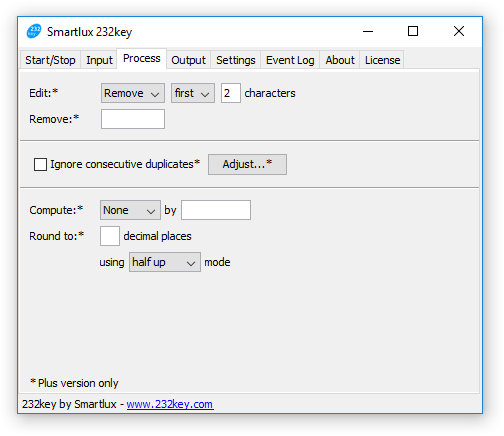
This function works only on the captured characters (highlighted in blue in the event log tab), not on the entire line of characters sent form your device. To change which characters are captured, modify the regular expression.
Remove characters
Added in version 2016.2
All instances of the characters you enter here will be removed from the captured data. This is very useful for class I and class II balances with an auxiliary indicating device (differentiated digits).
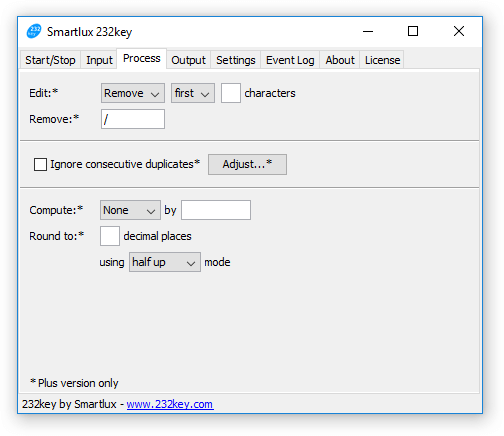
Ignore consecutive duplicates
Added in version 2016.2.3
Select this checkbox if you want 232key to automatically ignore consecutive duplicates, i.e. the same data captured multiple times in a row:

This can be very useful to prevent user mistakes like scanned a barcode twice.
Clicking on the Adjust button opens a dialog with two additional settings:

Time limit
This setting restricts the ignore function: If you enter a value (in milliseconds), the ignore function will check how much time has passed since the last data was captured. If the time limit is exceeded, the newly received data is always typed (even if it is a duplicate). In the example above, data received more than 2000 ms (2 seconds) after the last data was captured will always be typed.
Tolerance
This setting expands the ignore function. If
you enter a positive number (r), 232key uses a numeric
comparison and ignores all captured values
which fall within the tolerance range:
xprev - r ≤ xcurr ≤ xprev
+ r.
- x prev: Previous captured value.
- x prev: Current captured value (becomes new x prev for next comparison, even if it is ignored and therefore not typed).
- r: Positive value entered in the tolerance ± field (0.05 in the example shown above).
Mathematical operations (compute)
Added in version 1.08
You can apply mathematical operations to values captured by 232key before they are typed into another program. This can be useful for unit conversions.
Multiplication
Select "Multiply" and enter the factor (e.g. 1000 to multiply all measurement values by 1000):
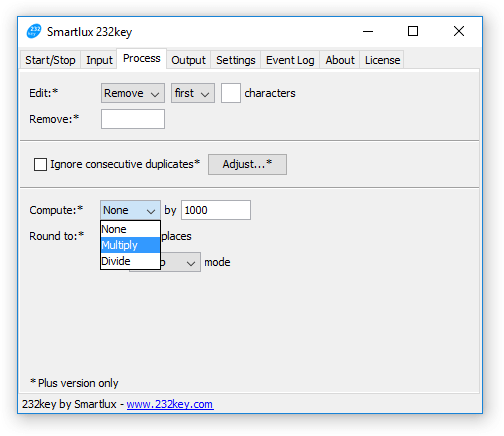
Factors do not have to be integers.
Division
Select "Divide" and enter the divisor (e.g. "1000" to divide all values by 1000):
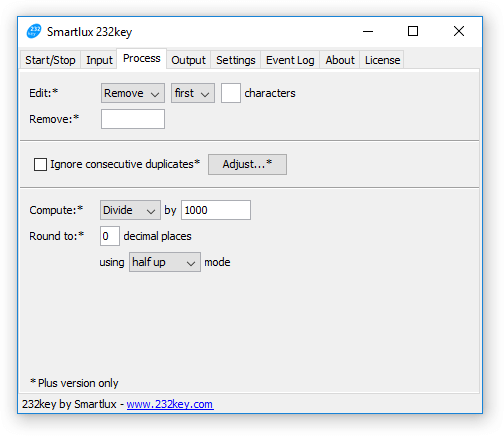
Divisors do not have to be integers. Rounding options have to be specified for division (see below).
Rounding
Rounding allows you to change the number of decimal places of the values which 232key types into your target application. Enter the number of decimal places in the field (0 to 7), leave empty to disable rounding.
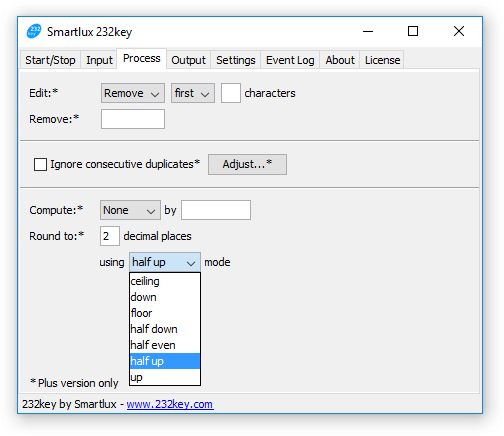
- If the original values have fewer decimal places than the number you entered, they'll not be padded (since version 1.08). This also means that integers will not be padded.
- Rounding is disabled if you've selected a " text" device in the input tab (e.g. "Barcode numeric (0-9)").
Rounding modes
As of version 1.06, 232key supports different rounding modes. Usually, you'll want to use "half-up" rounding (commonly taught in school, default mode in 232key) or "half-even" rounding (aka unbiased rounding, statistician's rounding). Please click on the names to see a detailed explanation with examples:
Inter-character delay
Added in version 1.10
Affects the simulated keyboard output and lets you change the default delay of 20
milliseconds between characters to a value from 0 (no delay) to 1000
ms. A value of 5ms will work on most systems, though you may have to increase it
if your target application cannot handle the speed at which 232key
simulates keystrokes):
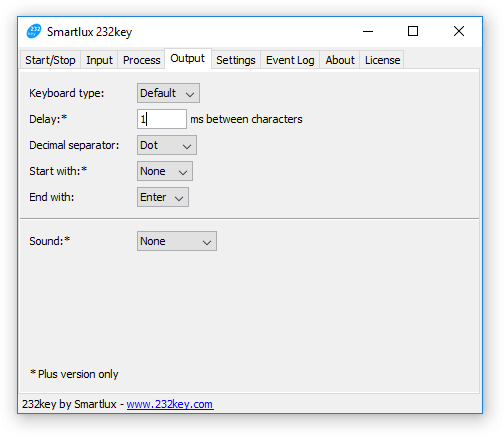
"Start with" key
Added in version 1.07
Allows you to specify a key to be pressed ahead of the data. As of version 2020.1, you can select one of the following keys:
- Enter
- TAB
- * (Numpad)
- Comma
- Delete
- Down arrow
- Esc
- F1-F12 function keys
- Right arrow
- Semicolon
- Space
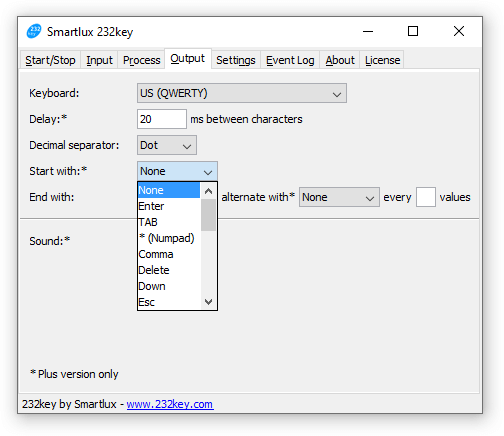
Alternate "end with" key
Added in version 2017.1.3
Enables 232key to alternate between pressing two different keys after typing the value. The input field allows you to specify when the alternate second key should be pressed (every x values with 2 ≤ x ≤ 99):
Example: Your device sends three values in
separate lines (which are all captured by 232key). You want them to
be typed in three rows:
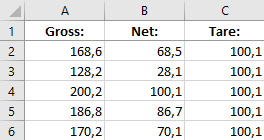
To do so, end with "TAB" and alternate
with "Enter" every "3" values:
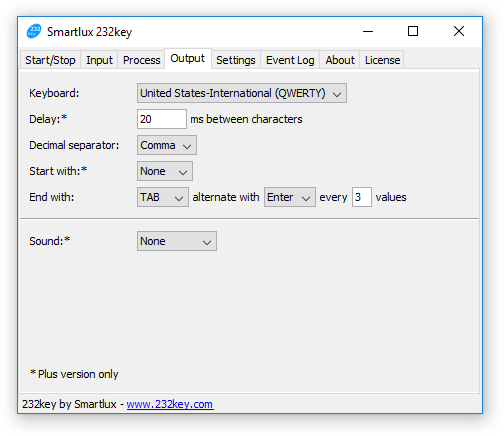
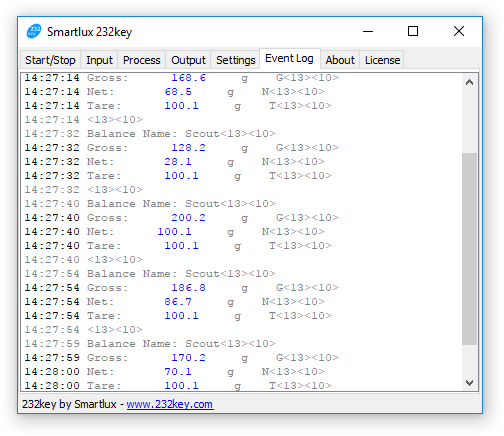
Sound
In the output tab, you can select a confirmation sound for 232key to play each time a new
value
has been received and is being typed:
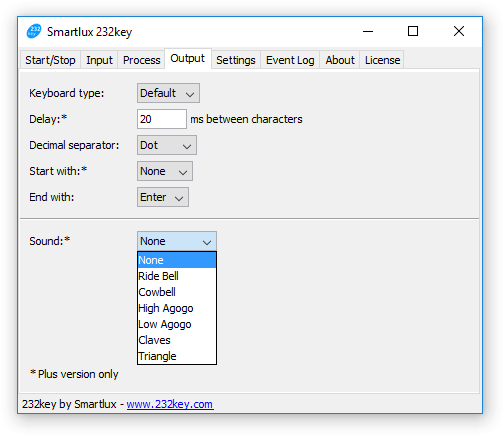
This feature is particularly useful if the serial device you're using doesn't make any sound itself when transferring data (or a device which always makes a sound as soon as the "data" key is pressed, even when no data is actually sent).
Auto-start
Instead of pressing the start button in the start/stop tab, 232key Plus allows you to select the auto-start option in the settings tab. 232key will then automatically
connect to your device and start the keyboard simulation when you
run the program.

You can also instruct 232key to abort auto-start if the previously used port is not longer available, minimize to the notification area (often called "system tray"), display a notification after being minimized (see image below) and to skip the update check by checking or unchecking the corresponding boxes.
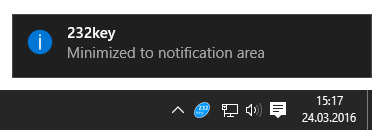
- To open 232key from the minimized state, double-click on the icon in the notification area.
- These settings will come into effect the next time you run 232key (restart required).
- If you want 232key to run automatically when Windows starts, you'll have to place a shortcut in the "startup" folder. See this blog post for further information.
Import / export configuration
Added in version 1.62
All settings made in 232key can be exported to or imported from a
file:

- The license key is not exported and cannot be imported.
- The program has to be restarted after importing the configuration.
